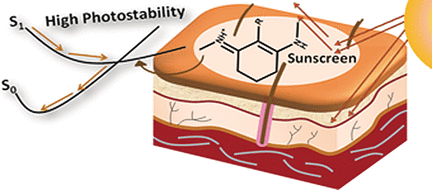Boosting the solar protection factor with rationally designed, nature-inspired sunscreens

The ideal sunscreen should block UVB and UVA radiation while being safe and stable. In the journal Angewandte Chemie, Spanish scientists have introduced a new family of UVA and UVB filters based on natural sunscreen substances found in algae and cyanobacteria. They are highly stable and enhance the effectivity of commercial sunscreens.
Good news for sunseekers. Commercial available sunscreen lotions can very effectively protect from dangerous radiation in the ultraviolet, but they need to be applied regularly and in high amounts to develop their full potential. One of the most critical issues is the limited stability of the UV filter molecules. Inspired by nature, Diego Sampedro and his colleagues from La Rioja University in Logroño and collaborators from Málaga University and Alcalá University, Madrid, Spain, have screened a natural class of UV-protecting molecules for their possible use in skin protection. They adjusted the nature-given motif to the requirements of chemical synthesis and found that the molecules could indeed boost the sun protection factor of common formulations.
The natural sunscreen molecules are called microsporine-like amino acids (MAAs) and are widespread in the microbial world, most prominently in marine algae and cyanobacteria. MAAs are small molecules derived from amino acids, thermally stable, and they absorb light in the ultraviolet region, protecting the microbial DNA from radiation damage. Thus they are natural sunscreens, which inspired Sampedro and his colleagues to create new class of organic sunscreen compounds.
Theoretical calculations revealed what is chemically needed for a successful design. "We performed a computer calculation of several basic scaffolds [..] to identify the simplest compound that fulfills the requisites for efficient sunscreens", the authors write. The result of their search was a set of molecules which were readily synthesized, "avoiding the decorating substituents that come from the biosynthetic route." Thus the small basic molecules can be tuned to give them more favorable properties.
The authors found that the synthesized compounds are characterized by excellent filter capacities in the relevant UV range. In addition they are photostable, much more than, for example, oxybenzene which is a widely used sunscreen in commercial formulations. They do not react chemically and dissipate radiation as heat (but not to such an extent that the skin temperature would rise as well). And, most importantly, when tested in real formulations, the sun protection factor (SPF) rose by a factor of more than two. Thus they could be promising targets for more stable, more efficient sunscreen lotions. Good news for your next summer vacation.
More information: Raúl Losantos et al. Rational Design and Synthesis of Efficient Sunscreens To Boost the Solar Protection Factor, Angewandte Chemie International Edition (2017). DOI: 10.1002/anie.201611627
Journal information: Angewandte Chemie , Angewandte Chemie International Edition
Provided by Wiley


















